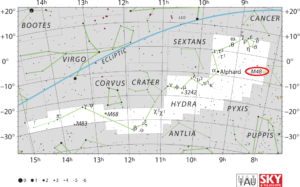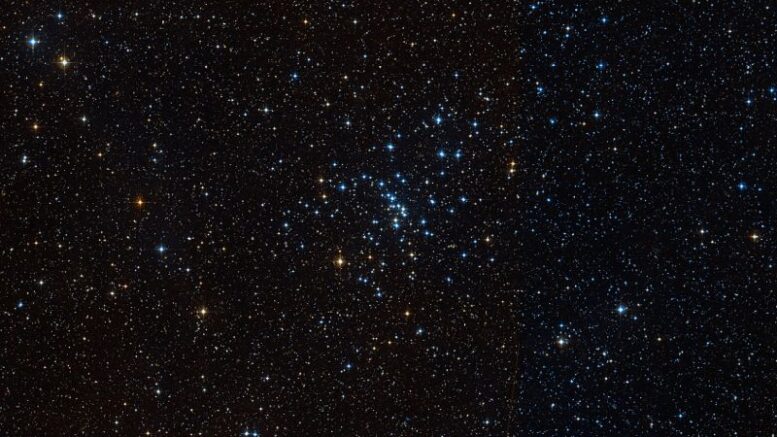Messier 48 (M48) is an open star cluster located in Hydra, the largest constellation in the sky.
| Description | |
| Visible From Pacific Northwest | October to March |
| Best Time To Observe | January and February |
| Minimum Size Of Viewing Device | Binoculars |
| Object Type | Open Cluster |
| Designations | Messier 48, M48, NGC 2548, Collinder 179, C 0811-056, MWSC 1454 |
| Right Ascension | 08h 13.7m |
| Declination | -05°45′ |
| Constellation | Hydra |
| Number Of Stars | More Than 80 |
| Apparent magnitude | +5.5 |
| Apparent dimensions | 54′ |
| Object Radius | 11.5 light years |
| Distance From Earth | 1,500 light years |
History
Charles Messier added the cluster to his catalogue on February 19, 1771. However, M48 was considered one of the lost Messier objects for a long time because the coordinates provided by Messier did not match those of NGC 2548: his declination was off by 5 degrees.
Messier described M48 as a “cluster of very small stars, without nebulosity,” noting that “this cluster is at a short distance from the three stars that form the beginning of the Unicorn‘s tail.”
As Messier’s 48th entry was considered lost, the cluster was independently discovered by the German astronomer Johann Elert Bode around 1782 and German-British astronomer Caroline Herschel on March 8, 1783. She noted that the cluster was “at an equal distance from 29 [Zeta] & 30 Monocerotis, making an equilateral triangle with those two stars is a nebulous spot. By the telescope it appears to be a cluster of scattered stars. It is not in Mess. catalogue.”
It was the German astronomer Oswalt Thomas who identified the cluster as NGC 2458 in 1934. Canadian astronomer T.F. Morris identified the cluster independently in 1959.
Locating M48 In The Sky
Messier 48 can be found 14 degrees to the southeast of Procyon, the brightest star in Canis Minor and eighth brightest star in the sky, or 3 degrees southeast of Zeta Monocerotis, a yellow supergiant with an apparent magnitude of 4.36, located in the constellation Monoceros.

Viewing M48
The best way to observe M48 is at low magnifications as it covers an area almost twice the size of the full Moon.
The cluster is easily seen in binoculars and small telescopes, which reveal about 50 stars brighter than magnitude 13
Photographing M48
Photographing Messier 48 can be done in a way that most open clusters, which requires accurate guidance if using long exposures. It is possible to maintain possible to not use a guidance system, but that will require a smaller exposure time. Crispness is crucial, and a photograph should typically have an exposure time of 2 to 5 minutes.
http://www.deeplook.astronomie.at/laplama_blauensteiner_sdp_messier%2048.htm
https://www.astrobin.com/332049/B/?nc=all
http://www.derbyastronomy.org/M48.htm
Sources And Further Reading
Descriptions of all of Messier Objects can be found here.
https://freestarcharts.com/messier-48
https://www.messier.seds.org/m/m048.html

Leave a comment